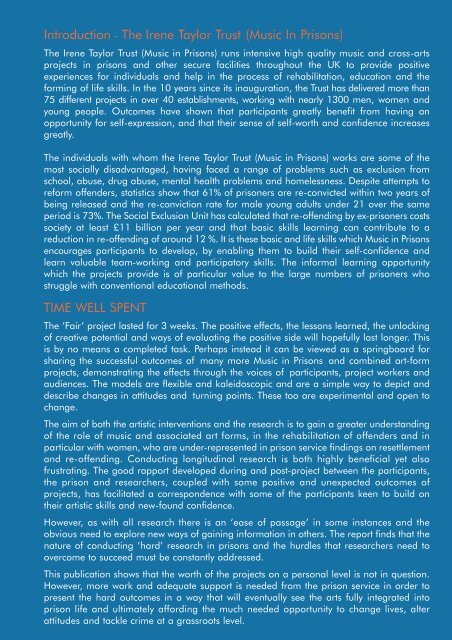download - Music in Prisons
download - Music in Prisons
download - Music in Prisons
You also want an ePaper? Increase the reach of your titles
YUMPU automatically turns print PDFs into web optimized ePapers that Google loves.
Introduction - The Irene Taylor Trust (<strong>Music</strong> In <strong>Prisons</strong>)<br />
The Irene Taylor Trust (<strong>Music</strong> <strong>in</strong> <strong>Prisons</strong>) runs <strong>in</strong>tensive high quality music and cross-arts<br />
projects <strong>in</strong> prisons and other secure facilities throughout the UK to provide positive<br />
experiences for <strong>in</strong>dividuals and help <strong>in</strong> the process of rehabilitation, education and the<br />
form<strong>in</strong>g of life skills. In the 10 years s<strong>in</strong>ce its <strong>in</strong>auguration, the Trust has delivered more than<br />
75 different projects <strong>in</strong> over 40 establishments, work<strong>in</strong>g with nearly 1300 men, women and<br />
young people. Outcomes have shown that participants greatly benefit from hav<strong>in</strong>g an<br />
opportunity for self-expression, and that their sense of self-worth and confidence <strong>in</strong>creases<br />
greatly.<br />
The <strong>in</strong>dividuals with whom the Irene Taylor Trust (<strong>Music</strong> <strong>in</strong> <strong>Prisons</strong>) works are some of the<br />
most socially disadvantaged, hav<strong>in</strong>g faced a range of problems such as exclusion from<br />
school, abuse, drug abuse, mental health problems and homelessness. Despite attempts to<br />
reform offenders, statistics show that 61% of prisoners are re-convicted with<strong>in</strong> two years of<br />
be<strong>in</strong>g released and the re-conviction rate for male young adults under 21 over the same<br />
period is 73%. The Social Exclusion Unit has calculated that re-offend<strong>in</strong>g by ex-prisoners costs<br />
society at least £11 billion per year and that basic skills learn<strong>in</strong>g can contribute to a<br />
reduction <strong>in</strong> re-offend<strong>in</strong>g of around 12 %. It is these basic and life skills which <strong>Music</strong> <strong>in</strong> <strong>Prisons</strong><br />
encourages participants to develop, by enabl<strong>in</strong>g them to build their self-confidence and<br />
learn valuable team-work<strong>in</strong>g and participatory skills. The <strong>in</strong>formal learn<strong>in</strong>g opportunity<br />
which the projects provide is of particular value to the large numbers of prisoners who<br />
struggle with conventional educational methods.<br />
TIME WELL SPENT<br />
The ‘Fair’ project lasted for 3 weeks. The positive effects, the lessons learned, the unlock<strong>in</strong>g<br />
of creative potential and ways of evaluat<strong>in</strong>g the positive side will hopefully last longer. This<br />
is by no means a completed task. Perhaps <strong>in</strong>stead it can be viewed as a spr<strong>in</strong>gboard for<br />
shar<strong>in</strong>g the successful outcomes of many more <strong>Music</strong> <strong>in</strong> <strong>Prisons</strong> and comb<strong>in</strong>ed art-form<br />
projects, demonstrat<strong>in</strong>g the effects through the voices of participants, project workers and<br />
audiences. The models are flexible and kaleidoscopic and are a simple way to depict and<br />
describe changes <strong>in</strong> attitudes and turn<strong>in</strong>g po<strong>in</strong>ts. These too are experimental and open to<br />
change.<br />
The aim of both the artistic <strong>in</strong>terventions and the research is to ga<strong>in</strong> a greater understand<strong>in</strong>g<br />
of the role of music and associated art forms, <strong>in</strong> the rehabilitation of offenders and <strong>in</strong><br />
particular with women, who are under-represented <strong>in</strong> prison service f<strong>in</strong>d<strong>in</strong>gs on resettlement<br />
and re-offend<strong>in</strong>g. Conduct<strong>in</strong>g longitud<strong>in</strong>al research is both highly beneficial yet also<br />
frustrat<strong>in</strong>g. The good rapport developed dur<strong>in</strong>g and post-project between the participants,<br />
the prison and researchers, coupled with some positive and unexpected outcomes of<br />
projects, has facilitated a correspondence with some of the participants keen to build on<br />
their artistic skills and new-found confidence.<br />
However, as with all research there is an ‘ease of passage’ <strong>in</strong> some <strong>in</strong>stances and the<br />
obvious need to explore new ways of ga<strong>in</strong><strong>in</strong>g <strong>in</strong>formation <strong>in</strong> others. The report f<strong>in</strong>ds that the<br />
nature of conduct<strong>in</strong>g ‘hard’ research <strong>in</strong> prisons and the hurdles that researchers need to<br />
overcome to succeed must be constantly addressed.<br />
This publication shows that the worth of the projects on a personal level is not <strong>in</strong> question.<br />
However, more work and adequate support is needed from the prison service <strong>in</strong> order to<br />
present the hard outcomes <strong>in</strong> a way that will eventually see the arts fully <strong>in</strong>tegrated <strong>in</strong>to<br />
prison life and ultimately afford<strong>in</strong>g the much needed opportunity to change lives, alter<br />
attitudes and tackle crime at a grassroots level.


